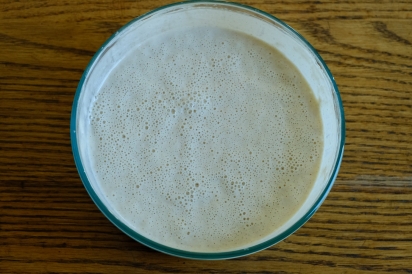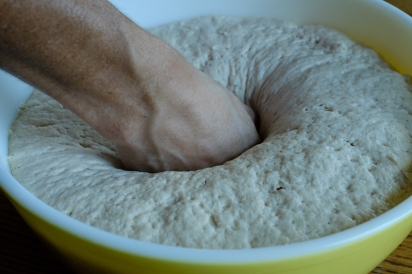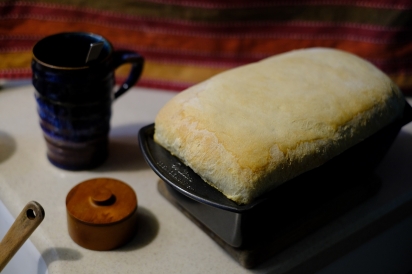Splendid Sourdough: Cultivating comfort and connection
Last night, my husband and I shared this typical exchange:
“Are you coming into the living room soon?” he asked.
“Yeah,” I replied. “After I feed Junior.”
Nothing unusual. Except that I wasn’t talking about a child or a pet. I was talking about my sourdough starter.
“Junior” is a hungry lad, who demands regular feedings. Fortunately, he never tires of the same old flour-and-water meal he’s been eating since birth. And so long as I keep him well fed, he feeds us well, in turn.
My own interest in sourdough began a few years ago. I’d read that those who experience gluten intolerance can often digest sourdough without difficulty. Intrigued, I researched more.
And then I promptly gave up. It all seemed so fussy, so obsessive, so scientific. I couldn’t imagine how my own spontaneous baking urges and tendency toward imprecision (and, OK—lingering commitment issues) could possibly jibe with sourdough’s specificity.
But then we met Joseph, an Airbnb host in New Zealand, who offers a fresh loaf of organic sourdough as an add-on option—one we requested unhesitatingly.
Joseph had our loaf waiting for us in the kitchen by 8 a.m., alongside a blue ceramic bowl of just-gathered eggs. We smelled it before we saw it: the unmistakable aroma of freshly-baked bread. The earthy scent was wildly alive, its heady lusciousness too big to be contained by that little room.
And then our eyes came to rest on the diminutive loaf that was the source of all of this olfactory awe: a perfectly round, tawny-crusted sourdough boule, fetchingly cooling on the butcher block table.
Did we order another for our second morning? You bet your boule we did.
We arrived back in Erie newly inspired to make sourdough part of our lives. And Junior was born.
But before you get the impression that I’m one of those coddling types who loves to spend her waking hours in the service of sourdough, allow me to set the record straight. And hopefully, to dispel a few myths about sourdough.
SOURDOUGH BREAD IS TOO, WELL, SOUR.
Actually, sourdough is not a type of bread. Rather, it’s the traditional way of making bread. As Sam Sifton explains in The New York Times, “Sourdough starter is simply flour and water left to ferment, a medium that supports the wild yeast and lactobacilli that surround us all. Fed with more flour, and more water, a sourdough eventually achieves a kind of symbiosis that helps dough rise, without the use of cultivated yeast.”
In The Art of Fermentation, Sandor Ellix Katz emphasizes that “Sourdough bread does not have to be sour.”
I’ve experimented with ways to make Junior sour enough for my palate, by adding a bit of rye flour, and by manipulating acidity by feeding less frequently. Essentially, making your starter a tad “hangry” gives it that delectably piquant flavor many of us equate with sourdough bread. It tastes like a pout. But again: It doesn’t have to.
BREAD IS UNHEALTHY.
This one’s tricky, isn’t it? Bread’s cultural significance is virtually universal, but it’s gotten a bad rap in our diet-obsessed society. And no wonder, as many commercial breads are laden with low-quality flours and additives that confuse our bodies. Sourdough may be cultivated using gluten-free flours. But unless you have medical reasons to avoid wheat, traditional sourdough might do you some good.
A 2013 Guardian article, “Why Sourdough Bread is Good for You,” explains that lactic acids in sourdough “make the vitamins and minerals in the flour more available to the body” and “lower the bread's glycaemic [sic] index (GI), so it doesn't cause undesirable spikes in insulin. They also render the gluten in flour more digestible and less likely to cause food intolerance.”
Katz adds, “With wheat flour, researchers have found that mixed-culture sourdough pre-digestion results in ‘highly significant’ increased available lysine content and diminished presence of gluten.”
The homemade sourdough bread I eat daily, using only high-quality organic flours, has never caused digestive strife (or added pounds, for that matter). I also make yogurt, and substitute the strained whey for water when baking, which enriches both nutritiousness and deliciousness.
SOURDOUGH IS TOO COMPLICATED.
Sourdough bread’s basic ingredients are flour, water, and a little salt—quite simple, really. But it does take a bit of planning ahead. The fact that I have surrendered to this is a testament to how devoted I’ve become.
All the same, myriad resources substantiate sourdough’s forgiving nature; that it’s one of the more flexible cultures one might keep (see below for tips on getting started). And let me assure you, I have tested this forgiveness repeatedly.
Junior puts up with a lot. I forget to feed him, let him dry out. Sure, he might get a little bitter, but as soon as I show him the attention he deserves, he’s right back to being his bubbly self. And on baking day, no matter what I’ve put him through, he always rises to the occasion.
Now a confession: While kneading dough by hand fosters a certain romanticism, exacerbating tendinitis in my right arm does not. So rather than investing hundreds in a KitchenAid Artisan mixer, a second-hand bread machine on the dough setting does the heavy lifting for me. Works like a charm.
SOURDOUGH MAINTENANCE = WASTING FOOD.
The thought of throwing away any food is horrifying, so I just don’t. Instead, if I’m not baking right away, I keep Junior in the fridge—fasting, so to speak—then bring him to room temperature and resume hearty feedings a couple of days prior to baking.
Meanwhile, recipes abound using “discarded” or “unfed” sourdough starter. King Arthur Flour has a delightful recipe for sourdough crackers, flavored however you wish. Sourdough pancakes are also divine, made savory or sweet. (See sidebar for resources.)
Another option is to share your starter. Junior’s brethren now bubble in Brooklyn, and elsewhere in Erie, each deeply influenced by where they live—as we all are.
In fact, “Sourdoughs cultivated by people in different places, using different flours and methods, can be very distinctive,” explains Katz. “They become their environment and, to a lesser degree, what they are fed.”
Katz quotes baker Daniel Leader, author of Local Breads, who calls “every loaf of sourdough bread a local product.”
How fitting, then, that sourdough is made from a culture, biologically, and also contributes to culture, socially.
Sourdough connects its cultivators to traditional bread bakers the world over, centuries into the past, and to our particular locales in the here and now. And while so much of nature sleeps, winter is the perfect time to bring a “Junior” to life in your own kitchen.
STUDYING UP ON SOURDOUGH
Endless methods exist for proper sourdough stewardship, but here are a few resources I’ve found helpful.
The Art of Fermentation: An In-Depth Exploration of Essential Concepts and Processes from around the World, Sandor Ellix Katz, Chelsea Green Publishing, 2012.
“The simplest way of starting a sourdough from scratch is to mix a small amount of flour and water in a bowl, a little more flour than water, and stir until smooth,” simplifies Katz.
Stir vigorously, and place the starter in a warmish place, covered with something that allows it to breathe, like a towel.
About a day later, feed the starter some flour and water again. Repeat this process until you have a bubbly little Junior, ready for lovin’ and leaven.
“Beyond that,” Katz assures us, “all sourdough requires is a little patience and persistence.”
kingarthurflour.com
My online go-to for troubleshooting and recipes, especially those using “discarded” excess starter. Also try culturesforhealth.com, theperfectloaf.com, or a wealth of other entertaining forums.
agardenforthehouse.com
“Lifestyle guru” Kevin Lee Jacobs approaches sourdough baking with exuberance, practicality, and hilarious dashes of wit. I bake his versions of boule and sandwich loaf (which I make whole wheat) weekly.
Favorite flours
Farmer Ground Flour from Trumansburg, NY, available in several WNY locations, whose organic all-purpose is full-flavored and earthy. farmergroundflour.com
King Arthur Flour, 100 percent employee-owned and a certified B Corporation, whose organic bread and all-purpose flours have never failed me. kingarthurflour.com
Bob’s Red Mill, also 100 percent employee-owned, whose organic whole wheat makes a wholeheartedly sweet loaf. bobsredmill.com
— K.C.








